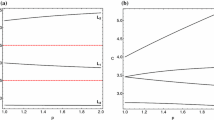Abstract
In a restricted circular three-body problem, the concept of the minimum velocity surface \(\mathscr{S}\) is introduced, which is a modification of the zero-velocity surface (Hill surface). The existence of the Hill surface requires the occurrence of the Jacobi integral. The minimum velocity surface, apart from the Jacobi integral, requires conservation of the sector velocity of a zero-mass body in the projection on the plane of motion of the main bodies. In other words, there must exist one of the three angular momentum integrals. It is shown that this integral exists for a dynamic system obtained after a single averaging of the original system over the longitude of the main bodies. The properties of \(\mathscr{S}\) are investigated. We highlight the most significant issues. The set of possible motions of the zero-mass body bounded by surface \(\mathscr{S}\) is compact. As an example, surfaces \(\mathscr{S}\) for four small moons of Pluto are considered within the averaged Pluto–Charon–small satellite problem. In all four cases, \(\mathscr{S}\) is a topological torus with a small cross section, having a circumference in the plane of motion of the main bodies as the center line.






Similar content being viewed by others
Change history
16 March 2021
An Erratum to this paper has been published: https://doi.org/10.1134/S1063454121010143
REFERENCES
M. F. Subbotin, Introduction to Theoretical Astronomy (Nauka, Moscow, 1968) [in Russian].
V. Szebehely, Theory of Orbits (Nauka, Moscow, 1982; Academic, New York, 1967).
L. G. Lukianov and G. I. Shirmin, Lectures on Celestial Mechanics (Evero, Almaty, 2009) [in Russian].
V. A. Antonov, I. I. Nikiforov, and K. V. Kholshevnikov, Theory of Gravitational Potential Elements, and Several Cases of Its Explicit Expression (S.-Peterb. Gos. Univ., St. Petersburg, 2008) [in Russian].
M. A. Vashkovjak, “On the stability of circular asteroid orbits in an N-planetary system,” Celestial Mech. 13, 313–324 (1976). https://doi.org/10.1007/BF01228649
M. A. Vashkovjak, “Method for calculating secular perturbations of asteroid orbits,” Kosm. Issled. 24, 513–526 (1986).
M. Brozović, M. R. Showalter, R. A. Jacobson, and M. W. Buie, “The orbits and masses of satellites of Pluto,” Icarus 246, 317–329 (2015).
Funding
The equipment of the Computing Center and Research Park of St. Petersburg State University was used for the study. The paper was supported by the Russian Foundation for Basic Research, project no. 18-02-00552.
Author information
Authors and Affiliations
Corresponding authors
Additional information
Translated by N. Semenova
About this article
Cite this article
Kholshevnikov, K.V., Titov, V.B. Minimal Velocity Surface in a Restricted Circular Three-Body Problem. Vestnik St.Petersb. Univ.Math. 53, 473–479 (2020). https://doi.org/10.1134/S106345412004007X
Received:
Revised:
Accepted:
Published:
Issue Date:
DOI: https://doi.org/10.1134/S106345412004007X



